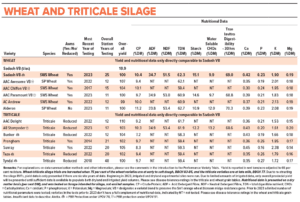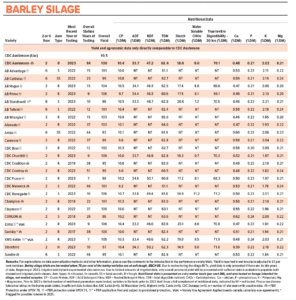2023 Regional Silage Variety Trials
This annual publication provides information on barley, oat, wheat and triticale variety silage performance in Alberta. These tables provide important yield and nutritional information. Information on agronomic traits and disease resistance can be found in the grain tables. In 2022, the Alberta Seed Processors secured funding to restructure Alberta’s regional silage variety trial program. As part of this, the Alberta Regional Variety Advisory Committee (ARVAC) testing program for cereals and flax expanded to include a silage subcommittee. The information and tables are prepared, reviewed and approved by ARVAC’s silage subcommittee.
Funding for the program is generously provided by public and private industry groups:
- Alberta Beef
- Alberta-British Columbia Seed Growers
- Alberta Seed Processors
- Results Driven Agriculture Research
- AgQuest – Taber, Alta.
- Agriculture and Agri-Food Canada – Lethbridge, Alta.
- Gateway Research Organization (GRO) – Westlock, Alta.
- Lakeland Applied Research Association (LARA) – St Paul, Alta.
- Olds College — Field Crop Development Centre – Lacombe, Alta.
- Prairie Grain Development Committee
For 2023, barley forage registration data from Alberta sites was incorporated into the silage RVT database.
Impact of Growing Season on Data Quality
Yearly trial results are greatly impacted by the growing season. There were two irrigated sites, at Taber and Lethbridge, and four dryland sites, at Lethbridge, Lacombe, St Paul and Westlock, in 2023. The 2023 growing season started off dry and didn’t recover at Lethbridge. At other sites, timely rains later in the growing season and/or irrigation resulted in generally good growing conditions. Data sets which didn’t pass minimum statical quality and experimental standards were excluded. The per cent of useable data from the 2023 barley silage trials was 67 per cent, oat silage trials was 67 per cent, and the combined wheat and triticale silage trials was 83 per cent. Overall, 72 per cent of the 2023 regional variety trial silage data was useable for inclusion in the January 2024 table publication.
ARVAC Silage Subcommittee
The ARVAC silage subcommittee consists of representatives from the seed industry, producer groups, university and government. The ARVAC silage subcommittee members and experts who guided the 2023 field season were:
- Vern Baron, Agriculture and Agri-Food Canada
- Hari Poudel, Agriculture and Agri-Food Canada
- Karin Schmid, Alberta Beef
- Jake Bueckert, Alberta Cattle Feeders
- Stacey Meunier, Alberta Cattle Feeders
- Gezinus Martens, Alberta Milk
- Monica Klaas, Alberta Seed Processors – secretary
- Rob MacDonald, Alliance Seed
- Brian Kennedy, Canterra
- Michelle Beaith, FP Genetics
- Mazen Aljarrah, Olds College – Field Crop Development Centre
- Yadeta Kabeta, Olds College – Field Crop Development Centre
- Trent Whiting, SeCan – chair
- Jeff Jackson, SeedNet
- Sheri Strydhorst, silage regional variety trial coordinator
- Dick Puurveen, University of Alberta
- Greg Penner, University of Saskatchewan – nutritional crop coordinator
Sincere thanks are extended to all individuals and organizations who contribute to this publication.
Trial Information
There were 15 barley, seven oat, five wheat and one triticale entries in the 2023 silage variety trials. The barley and oat were seeded to achieve 28 plants per square foot; wheat was seeded to reach 33 plants per square foot and triticale was seeded to achieve 35 plants per square foot. Fertilizer was applied based on soil test recommendation to meet optimal silage yield goals in the various trial regions.
Barley silage trials are harvested when 75 per cent of the barley varieties are at soft dough, BBCH 85. Wheat-triticale silage trials are harvested when 75 per cent of the wheat varieties are at early to soft dough, BBCH 83-85, and the triticale varieties are at late milk, BBCH 77. Oat silage trials are harvested when 75 per cent of the varieties are at milk stage, BBCH 75. However, the 2023 trials contained oat varieties with a wide range of development, with some locations showing a week or more difference in growth stages. This results in some of the later maturing varieties having lower yield and altered quality.
Yield Data Presentation
Yield data should only be compared with the check variety. Yield of the check variety is expressed as wet tons/ac adjusted to 65 per cent moisture. It should also be noted that yields are from small plot trials, which can be higher than yields expected under commercial production.
Similar to the cereal grain tables, silage yield data is only presented if there are six site-years of data in a yield category. Beginning in 2023, irrigated and dryland experimental sites were run. Due to limited amounts of irrigated data, only overall provincial yield will be presented until sufficient data is available to populate both dryland and irrigated yield columns. Yield data from fewer than six site-years can be very misleading which is why the change has been made to only present yield data where is there are at least six site-years of data, from several sites, to represent the potential of a variety.
Nutritional Analysis
Nutritional data is presented on a dry matter basis (per cent DM), and was tested on forage intended for silage, not ensiled samples. Nutrition information was assessed using NIRS at Murphy Analytical. Nutritional data is presented on a dry matter basis for the following parameters: CP = Crude Protein; ADF = Acid Detergent Fibre, NDF = Neutral Detergent Fibre, TDN = Total Digestible Nutrient; CHOs = Carbohydrates; Ca = Calcium; P = Phosphorous; K = Potassium; Mg = Magnesium. Prior to 2023 a limited number of nutritional parameters were tested; varieties in the tests prior to 2023 don’t have a full complement of nutritional data, indicated by NT = Not Tested.
It’s important to test silage prior to feeding, for its actual nutritional content, as growing conditions and growth stage at harvest can have significant impacts on feed value. Nutritional data presented here are for the purpose of variety comparison information rather than feed calculations.




